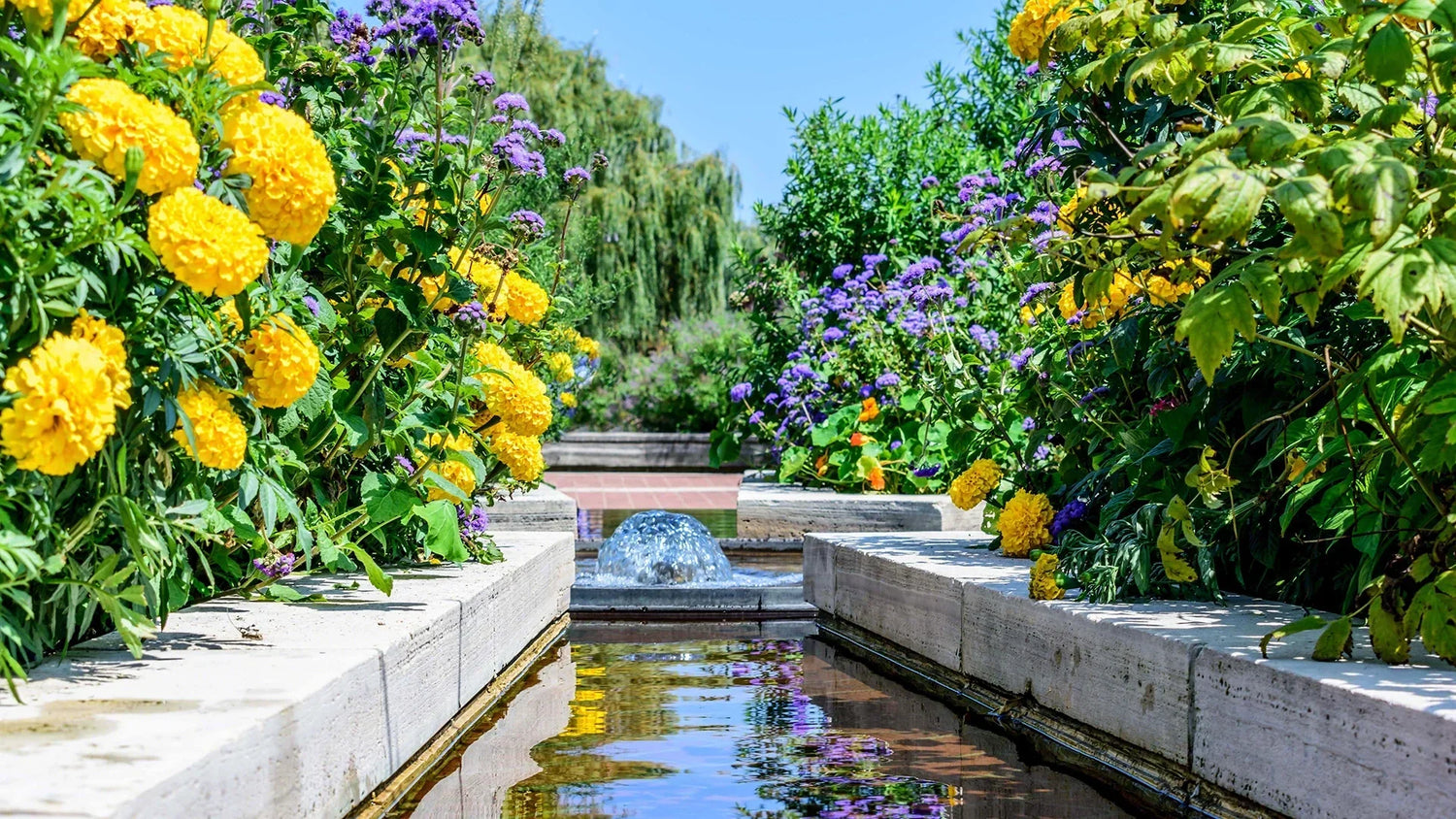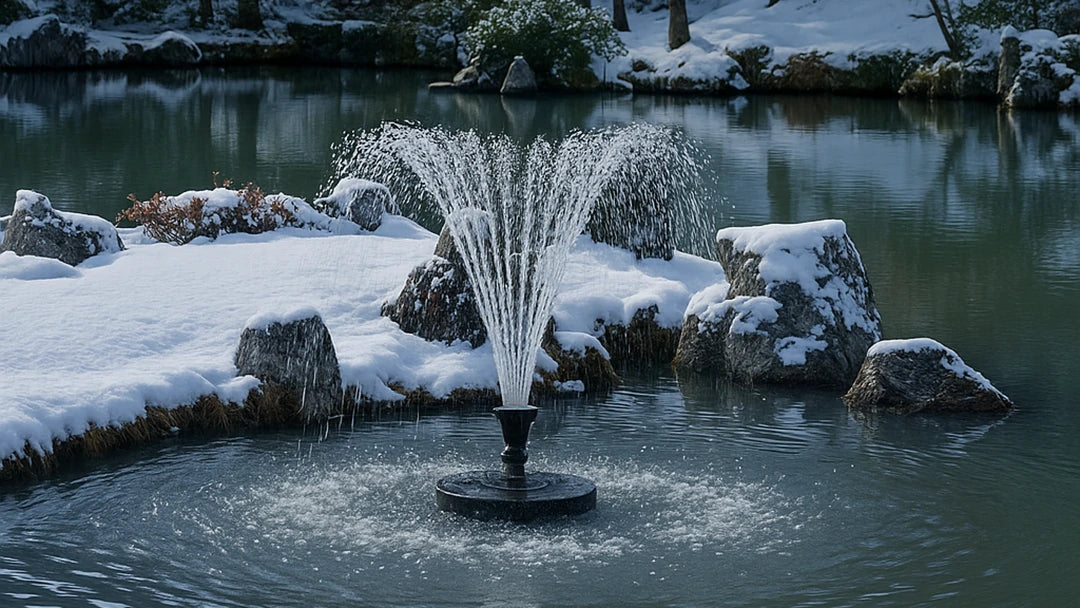You want a pond that dazzles in summer, survives winter without drama, and never turns into a weekend-eating chore. The secret isn’t luck—it’s rhythm. With a short, repeatable seasonal pond maintenance routine and the right gear, you can keep water clear, fish healthy, and plants thriving on autopilot. Use this practical pond care checklist as your year-round playbook, then plug in Poposoap’s solar-first tools so circulation and filtration run quietly in the background.
Differences Between Maintenance in Spring, Summer, Autumn, and Winter
Spring (Reset and Restart)

As temperatures rise, debris decomposes quickly and bio-filters wake up. Skim out leftover leaves, trim dead plant matter, and restart circulation early. Rinse mechanical foams and confirm your pump and hoses are clear. Begin light feeding for fish once water is consistently above ~50°F/10°C. If you use lilies, repot or divide now so they can anchor and shade the surface.
Summer (Stability and Oxygen)

Warm water holds less oxygen, so prioritize flow and shade. Keep your solar fountain or Poposoap Floating Pond Fountain running to agitate the surface and discourage mosquito larvae. Top off evaporation with dechlorinated water, thin fast-growing plants, and feed modestly to prevent nutrient spikes. A gentle Poposoap Waterfall Kit adds cooling and gas exchange during heatwaves.
Autumn (Clean and Protect)

Leaves are your main adversary. Net them early, prune marginals, and vacuum settled sludge before it fuels winter ammonia. Reduce feeding as temps fall. This is the best moment to deep-rinse filter foams and check bio-media flow paths. Consider adding a Poposoap Solar Pond Light set to warm white—the soft illumination helps you monitor fish and water clarity as daylight shortens.
Winter (Hands-Off Survival)

Aim for steady oxygen and a vent for gas exchange. Keep a low-draw fountain or waterfall running if your climate allows; otherwise, maintain an opening in the ice with moving water from a solar pump positioned shallow (never on the very bottom). Avoid major cleanings now—let the pond rest. Observe fish quietly; they’re conserving energy.
Preparation of Tools and Consumables
Keep a compact kit ready so you can act in minutes, not hours:
- Leaf skimmer, pond vacuum or sludge pump, pruning shears.
- Spare pump pre-filters and hose clamps; non-toxic liner patch.
- Beneficial bacteria (liquid or dry) for spring start and post-clean doses.
- Water test strips (pH, ammonia, nitrite, nitrate) to catch problems early.
- Dechlorinator for top-ups.
- Poposoap staples: a Solar Pond Filter (multi-stage foams + bio-media, optional UV), a Floating Pond Fountain for aeration and surface movement, a Waterfall Kit for circulation and cooling, and Pond Lights (IP-rated, submersible ABS housings) for safe night checks.
- Optional: protective netting, plant baskets, aquatic soil, and pea gravel for tidy shelves.
Poposoap Recommended Cycle

Poposoap designs are modular and solar-first, which makes a simple yearly pond care rhythm easy:
- Daily Glance (all seasons): Confirm flow from your Poposoap Solar Fountain Pump or Waterfall Kit; clear any leaf mats from inlets.
- Weekly (spring–fall): Skim debris, thin floaters, and swish coarse foams from the Poposoap Solar Pond Filter in pond water (not tap) to preserve bacteria.
- Bi-weekly (summer peaks): Check cable runs and solar panel angle; wipe panel dust. Top up water and re-dose beneficial bacteria after heavy cleanings.
- Monthly: Inspect tubing for kinks, tighten hose clamps, vacuum a light layer of settled mulm so it doesn’t become winter sludge.
- Quarterly: Review plant coverage (target ~50–60% in summer for shade), reposition lights, and refresh any activated-carbon pads if you’re fighting tannins.
- Pre-winter: Raise submersible pumps a few inches off the bottom to protect the warmest layer; keep a Floating Fountain on low to maintain a gas-exchange opening when feasible.
Prevention of Common Problems
- Green Water & String Algae: Balance is better than chemicals. Combine plant shade with constant circulation. A Poposoap Solar Pond Filter provides mechanical capture and a bio-bed; a waterfall return or floating fountain adds oxygen and breaks surface films. Dose beneficial bacteria after big cleans and during heat spikes.
- Low Oxygen (fish gasping at surface): Increase surface agitation immediately. Run your Floating Pond Fountain continuously in summer, and consider adding a spillway return for added gas exchange. Feed less until behavior normalizes.
- Clogged Pumps and Weak Flow: Fit a pre-filter box over the pump intake and clear it weekly in leaf season. Poposoap filter boxes are designed to intercept debris with layered foams so the pump keeps its prime.
- pH Swings: Small, frequent water changes (10–20%) with dechlorinated, temperature-matched water are safer than big dumps. Maintain consistent flow through bio-media to stabilize acids from fish waste.
- Mosquitoes: Movement is your friend. Keep a Poposoap Floating Fountain or solar fountain running in warm months; skim plant mats; avoid stagnant corners by directing your waterfall return across the widest span.
- Nighttime Predator Visits: Use Poposoap Pond Lights on a dusk schedule to illuminate the water column and make fishing birds think twice. Provide plant cover and deeper refuges (3-4 ft) for koi.
Calendar Reminder
Here’s a quick, human-friendly pond care checklist you can paste into your phone calendar:
- March–April (Spring Start): Restart pumps and filters, prune plants, vacuum sludge, re-seed bio-media with bacteria, test water weekly for a month.
- May–August (Summer Hold): Check flow daily, thin plants, spot-vacuum monthly, feed lightly, add shade if temps soar, wipe solar panels every two weeks.
- September–October (Autumn Prep): Net for leaves, deep-rinse coarse foams, trim marginals, reduce feeding, vacuum before first frost, confirm winter flow plan.
- November–February (Winter Watch): Keep a small opening with moving water if climate allows, avoid major cleanouts, observe fish quietly under Poposoap Pond Lights on low.
Final Word
A thriving pond is built on cadence, not constant work. Set your gear to do the heavy lifting—solar circulation from Poposoap fountains and waterfalls, layered filtration in a Poposoap filter box, and subtle lighting for safe night checks—and your seasonal pond maintenance shrinks to simple touch-ups. Follow this yearly pond care routine, and you’ll trade emergency fixes for effortless enjoyment, season after season.





Leave a comment
All comments are moderated before being published.
This site is protected by hCaptcha and the hCaptcha Privacy Policy and Terms of Service apply.